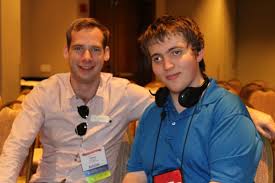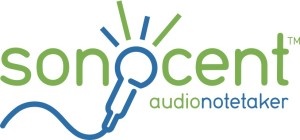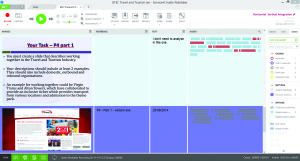 High school senior at Newton North High School in Newton, MA, Yishai Barth, feels strongly about the importance of Universal Design Language (UDL). He explains his specific learning needs and calls on all educators to see life from his and millions of other students’ perspective. By sharing his specific needs with teachers, needs that are faced by millions of students across the world, he hopes to provide help in supporting their learning.
High school senior at Newton North High School in Newton, MA, Yishai Barth, feels strongly about the importance of Universal Design Language (UDL). He explains his specific learning needs and calls on all educators to see life from his and millions of other students’ perspective. By sharing his specific needs with teachers, needs that are faced by millions of students across the world, he hopes to provide help in supporting their learning.
Thirty years ago a professor at Harvard University released findings from a series of studies. These findings have changed the way most experts in the field of psychology and neuroscience think about intelligence itself. Howard Gardner’s research revealed that from a practical perspective intelligence cannot be thought of as a singular noun. Instead it is necessary to consider the matrix of intelligences that exist in widely varied configurations within each human mind.
The Universal Design movement came into existence as a response to this research by leading thinkers in the engineering and design professions. It is imperative to the education of hundreds of thousands of students across the country and millions of students around the world that the techniques of Universal Design are brought to bear on the unjust barriers many students face in attempting to navigate the educational landscape under the status quo.
I have Cortical visual impairment (CVI), a decreased visual response due to a neurological problem affecting the visual part of my brain. I also have a perfect memory, super hearing, and a brain that works faster than most to solve complex problems in anything from theoretical physics to philosophy.
However, I am not the tiny niche audience that many would conclude. Research shows that people with dyspraxia alone represent between 2 and 6 per cent of the population. Add to this the fact that between 10 and 15 per cent of the US population are dyslexic, as well as the numerous obstructed readers and writers we have, and you start to realise that this isn’t an individually unique problem with limited participants. I use the term obstructed rather than reluctant as I, and many others love writing but just face challenges that make this harder to do.
If these students continue to be restricted when it comes to expressing their thoughts, their full potential will not be realised and the chances are they will become increasingly frustrated and drop out of the education system as early as possible.
But then we all have our own specific learning needs. Personally, I feel sorry for people who are put in the ‘normal’ category; their learning needs are not easily defined. Unlike most, my learning needs are clearly labelled; when I arrive at a college event or meeting my specific needs are immediately understood.
But do educators know how to support our requirements?
According to CAST, the association working to increase opportunities for everyone to learn, the way we all absorb information is as unique as our fingerprint.
Each student brings their own background, strengths, needs and interests and the curriculum should provide genuine opportunities for all to thrive. Without these, students will have no enthusiasm to gather the knowledge and develop skills. So how do teachers deliver a curriculum that challenges and supports these diverse learners?
If I had to sum up my needs in one phrase it would be that I am an auditory learner. My diversities mean that while I have hundreds of thoughts spinning around in my head, I am unable to translate these into written copy.
If we look at a standard day in any classroom, the activities and assessments are all channelled through writing. From elementary school grades upwards, a student may be given a book to read and asked to write a review afterwards. They then may move on to reading a poem and answering questions. In the afternoon they might be given a math or science assignment where they have to document the results.
The majority of lessons follow this format because in general, for most students, it works.
I engage in both the input and output of written material entirely non-visually, through sound. I have listened to every book I’ve ever read either in the voice of an appointed reader, the voice of a professional narrator or the synthesized voice of a screenreader. I have dictated every word I have ever written, either to a scribe, or to dictation software. In other words, because I am an auditory learner, I created an educational dynamic for myself where I engaged with my academics entirely auditorily through a dialogue or conversation with a person or a computer. Though various combinations of these techniques allowed me to succeed, it was a struggle. That struggle was problematic in many ways because much of it was incompatible with a traditional educational setting. It required a great deal of intuitive experimentation, improvisation and adaptation. This was a problem because in any context, outside of a public special education, it can often be hard to finance a competent and willing professional to serve as a scribe. Even when such an individual can be found and hired in or outside the context of an educational institution, no scribe is available all the time, every day, thus that methodology severely limits independence. This makes things difficult for someone like me, who constantly feels the urge to read interesting material and express my thoughts.
As with so many things, to a certain extent it should be a case of ‘technology to the rescue’! However technology’s effectiveness is always subject to the applicability of its design principles to any particular user. This is one of the fundamental principles of Universal Design. Voice recognition software is designed to eliminate the need for text input by typing. It assumes however, that its users are capable of at least some basic level of symbolic visual processing that can be used to rearrange and structure the raw output from the software. Similarly, most screenreader software is designed to eliminate the need for various kinds of visual processing in computing. Most screenreaders, however, make the assumption that a given user would be capable of inputting raw text on a keyboard by touch typing or muscle memory, assuming that the screenreader provided the proper feedback. A user like myself therefore, with learning challenges connected to both reading and writing, confounds the very principles underlying the design of these technical solutions.
Any technology not designed according to the principles of Universal Design is typically not capable of being adapted by the user in ways that may have been unforeseen by the designers. Therefore I was constantly fighting an uphill battle.
I worked very diligently over the course of my high school career to familiarize myself as much as possible with the inner workings, complex nuances, and the design principles of many forms of assistive technology. I tried numerous different solutions. However at a certain point I hit a wall with each of them.
 For auditory learners like me, at least, who struggle severely with reading and writing, a tool already exists. This tool is designed to address the learning needs of the millions of learners worldwide with print-related disabilities such as dyslexia and dysgraphia. This tool I use is called Sonocent Audio Notetaker. It allows me to engage with material and express myself purely in terms of sound and color, thus eliminating the need for any symbolic processing in my workflow. For students who, for whatever reason, are reluctant writers, this software fulfills a wide variety of common needs. It enables me to capture everything, from my own speech, to recordings of a teacher’s presentation, to audiobook excerpts, directly onto my laptop as an audio file. I can then highlight various parts of that audio using the software’s color highlighting tools. Teachers can highlight recorded speech where students are demonstrating progress, and add images, text and slides right alongside to gather evidence of development. I can use the color codes to categorize the recorded information by subject, lecture, or information priority. I can then add my own notes to summarize and edit my thoughts. I can cut and paste and re-organize the information down to the most minute detail.
For auditory learners like me, at least, who struggle severely with reading and writing, a tool already exists. This tool is designed to address the learning needs of the millions of learners worldwide with print-related disabilities such as dyslexia and dysgraphia. This tool I use is called Sonocent Audio Notetaker. It allows me to engage with material and express myself purely in terms of sound and color, thus eliminating the need for any symbolic processing in my workflow. For students who, for whatever reason, are reluctant writers, this software fulfills a wide variety of common needs. It enables me to capture everything, from my own speech, to recordings of a teacher’s presentation, to audiobook excerpts, directly onto my laptop as an audio file. I can then highlight various parts of that audio using the software’s color highlighting tools. Teachers can highlight recorded speech where students are demonstrating progress, and add images, text and slides right alongside to gather evidence of development. I can use the color codes to categorize the recorded information by subject, lecture, or information priority. I can then add my own notes to summarize and edit my thoughts. I can cut and paste and re-organize the information down to the most minute detail.
Sonocent Audio Notetaker has been crucial to my self-esteem and progress.
In today’s world of 21st Century learning, the traditional method of asking students to read and then write book reviews or answer comprehension questions is no longer necessary or appropriate; technology enables UDL where each student can learn and be assessed in a way that optimizes their learning advantage.
I call on teachers to recognize that these traditional teaching methods form barriers for pupils who are challenged to start writing. These pupils would benefit from talking about their ideas rather than putting pen to paper. When it comes to assessing students’ reading skills, it is important not to base this simply on their writing skills.
Obstructed writers like myself, can read perfectly well and have an in-depth understanding of the reading material, even if we chose not to write this down, or in my case, struggle to write this down.
I call on all educators and educational stakeholders to throw their weight behind that lunge so that new heights of educational accessibility and excellence can be reached around the world. If that support is given, we will see a future educational landscape dominated by educational software packages and other tools designed to address the needs of all students regardless of how common or individualized. Imagine a world of 21st century learning where Universal Design makes it possible for each student to learn and be assessed in a way that optimizes all of their learning advantages. Imagine a world of learning where no assignment has to be carried out according to a specific learning methodology, because Universal Design makes it possible for any learner to select from a diverse array of applications and other tools according to their natural neurological inclinations.
In this new world, for instance, a dyslexic student could use software like Sonocent to have all of their exams given orally. This would be a world where reluctant or previously obstructed aspiring writers like me, could be freely given the option to engage with written material and the act of writing entirely auditorily across all of their classes. In that world educators would have the freedom to challenge all the assumptions of traditional educational techniques in order to satisfy the actual needs of their actual students. In such a world, the barriers and injustices so many students face would crumble away, allowing many, for the first time, to experience the true glowing warmth of independent self-expression. I look forward to living in that world!
Jacqui Murray has been teaching K-18 technology for 30 years. She is the editor/author of over a hundred tech ed resources including a K-12 technology curriculum, K-8 keyboard curriculum, K-8 Digital Citizenship curriculum. She is an adjunct professor in tech ed, Master Teacher, webmaster for four blogs, an Amazon Vine Voice, CSTA presentation reviewer, freelance journalist on tech ed topics, contributor to NEA Today, and author of the tech thrillers, To Hunt a Sub and Twenty-four Days. You can find her resources at Structured Learning.





































I enjoy learning about tech tools from this blog. Today, I not only learned about this tool, but as a special education teacher, and the Aunt of a child with dyslexia, I can understand more clearly how usage of the software and support for a different way of assessing knowledge and interest will be able to benefit my students this coming year. Thank you!
I’m a big supporter of Sonocent for that very reason. I think they’ve made an effort to understand and serve the special learning styles of lots of kids. Kudos to them!